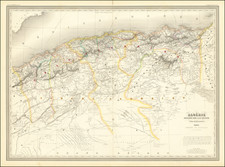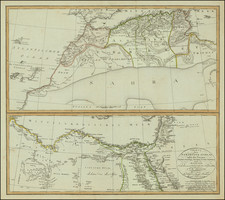An Extraordinary Rarity -- A Masterwork of the Venetian Publisher Giovanni Vavassore
Quite possibly the only surviving example of Giovanni Vavassore's finely engraved plan of Tunes -- one of the earliest surviving examples of Vavassore's work.
The map is one of the only contemporary depictions of the conquest of Tunis by a Christian Fleet under the Command of Emperor Charles V, prepared by Giovanni Vavassore, widely considered to be the most important early Italian mapmaker and highly regarded print maker from Venice.
Tunis was one of the most important naval bases of the Ottoman Empire in the western Mediterranean. Oriented with south at the top, this map provides an excellent overview of Tunis and its harbor and bay, with the fort of La Golette at the narrow point in the bay. The ruins of ancient Carthage are noted, as are the ancient aqueducts.
Executed in a quality reminiscent of the some of the old masters of engraving from the period, the details of the ships, fortifications and the competing Turkish and Christian armies is quite extraordinary.
Attribution, Dating, and Watermark
Our attribution of this work to Vavassore is based several factors. Laszlo Grof in an article in The Map Collector (see reference below), in which he attributes a map of Hungary to Vavassore, cites the present map as a known work by Vavassore. We have not been able to locate the copy cited by Grof. Also, the watermarks on the Hungary map and ours are very similar. Moreover, the present work's watermark, Briquet 3413 and/or 3414 (which appear to be the same ones) align correctly as to date and place of publication. The latter was found on a Venetian imprint of 1528 and the former on Vincenza imprint of 1528. Finally, there are unmistakable stylistic convergences between our map and Vavassore's other known works. His bold, rounded lines are highly distinctive.
Giovanni Vavassore
Giovanni Andrea Vavassore (1495 ca to 1572 ca) (also Zoan Andrea or Zav; Valvassore, Vavasore Vadagnino, Vadianus, Guadagnino), was a Venetian publisher and printer and one of the most important early Italian mapmakers. Woodward, in his essay on the Italian map trade (1480-1760), calls Pagano and Vavassore, the "early Venetian masters of map engraving" who came into their own in the 1530s. Woodward explains that Vavassore was born in Telgate and was working as an artist and blockcutter by 1510.
The British Museum and Whitcombe state that Vavassore started as a printmaker, but then started publishing as well around 1530. It was in that year (before November) that he published Opera nova contemplativa per ogni fidel christiano, which had 120 illustrations attributed to Giovanni's brother, Florio.
Vavassore was a member of a painters' guild in 1530, the same year he is listed as a book printer (as Vadagnin Zuan Andrea). From 1537-44, he shared his imprint with his brothers, but from 1544 onward he is the only one listed.
The dates and information on his cartographic works are variable. Woodward says that nine of his nineteen known geographic works are undated, a figure taken from Bagrow. None survive in more than four impressions. The earliest item Woodward cites is a 1515 woodcut of the Battle of Marignano. Vavassore's next dated map is that of Spain (1532), although there are undate works believed to pre-date 1532.
Tooley credits Vavassore with the view of Constantinople used by Braun and Hogenberg (produced circa 1520). Tooley also attributes a curca 1520 map of Central Europe and one of Rhodes (1522, also in Bagrow) to Vavassore. In 1532, he released Nova descriptio Hispaniae and, in 1536, a reduced copy of Oronce Fine's Nova totius Galliae desriptio. In 1539, Tooley credits him with creating a two-sheet portolan chart of the eastern Mediterranean, Adriatic, and Aegean Seas, supposedly the first printed chart intended for use at sea.
Vavassore's known maps from the 1530s are: France ( Nova totius Galliae descriptio, reduction of a Fine map as already noted, 1536, map 27/3.1, p. 176), Germany (in lower left corner: Opera di Giouani Andrea Vauassore ditto Vadagnino, copied in part from Eichstätt map attributed to Cusanus, ca. 1530, 23/1.7, p. 137 ( History of Cartography dates it to ca. 1538 (vol. II, p. 1821)), Spain ( Nova descriptio Hispaniae, 1532, p. 444, 606), and Venice (ca. 1535, one source for Pagano's later view of Venice, p. 615).
Rarity
Considered the most important early map engraver working in Italy, Vavassore's works are legendary rarities in the market, this being the first example of any Vavassore map we have seen on the market in more than 20 years. The most recent auction result we could find was a Sothebys 1993 offering of Vavassore's map of Russia (the earliest modern map of Moscovy), which sold for GBP 20,700.
The present map of Tunes was apparently unkown to Bagrow, Tooley and Woodward. To date, we confirm no other surviving examples.
Giovanni Andrea Vavassore (also Zoan Andrea or Zav; Valvassore, Vavasore Vadagnino, Vadianus, Guadagnino), the Venetian publisher and printer, was born in ca. 1495 and died in ca. 1572. According to the History of Cartography, his will was opened May 31, 1572. Woodward, in his essay on the Italian map trade (1480-1760), calls Pagano and Vavassore, one of the “early Venetian masters of map engraving” who came into their own in the 1530s. Woodward explains that Vavassore was born in Telgate and was working as an artist and blockcutter by 1510. In 1523, Vavassore described himself as an “incisor figuraturum” (vol. 1, p. 780).
The British Museum and Whitcombe say he started as a printmaker, but then started publishing as well around 1530. It was in that year (before November) that he published Opera nova contemplativa per ogni fidel christiano, which had 120 illustrations attributed to Giovanni’s brother, Florio (British Library (BL) listing says “1540?”). Tooley lists Vavassore as flourishing between 1510 and 1572, dates with which Bagrow concurs. The Leiden Textile Research Center gives his flourishing dates as 1530 to 1573, while the British Museum lists 1518 to 1572. The BL has several of his works dated to 1530 and 1532. In the 1550s and 1560s he attained privileges to print books, all of which had many woodcuts. Woodward’s article explains that he was a member of a painters’ guild in 1530, the same year he is listed as a book printer (as Vadagnin Zuan Andrea; Bagrow, introduction). From 1537-44, he shared his imprint with his brothers, but from 1544 onward he is the only one listed.
The dates and information on his cartographic works are variable. Woodward says that nine of his nineteen known geographic works are undated, a figure taken from Bagrow. None survive in more than four impressions. The earliest item Woodward cites is a 1515 woodcut of the Battle of Marignano. Vavassore’s next dated map is that of Spain (1532) (vol. 1, p. 780).
Tooley credits him with the view of Constantinople used by Braun and Hogenberg (ca. 1520). Tooley also attributes a ca. 1520 map of Central Europe and one of Rhodes (1522, also in Bagrow) to Vavassore. In 1532, he released Nova descriptio Hispaniae and, in 1536, a reduced copy of Oronce Fine’s Nova totius Galliae desriptio. In 1539, Tooley credits him with creating a two-sheet portolan chart of the eastern Mediterranean, Adriatic, and Aegean Seas, supposedly the first printed chart intended for use at sea (History of Cartography lists 1540; vol. 1, p. 21).
Karrow supports these early attributions, giving a date of ca. 1520s for Byzantium sive Costantineopolis. Opera di Giovanni Andrea Vavassore detto Vadagnino (map 87/15, pg. 615). The maps from the 1530s are: France (Nova totius Galliae descriptio, reduction of a Fine map as already noted, 1536, map 27/3.1, p. 176), Germany (in lower left corner: Opera di Giouani Andrea Vauassore ditto Vadagnino, copied in part from Eichstätt map attributed to Cusanus, ca. 1530, 23/1.7, p. 137 (History of Cartography dates it to ca. 1538 (vol. II, p. 1821)), Spain (Nova descriptio Hispaniae, 1532, p. 444, 606), and Venice (ca. 1535, one source for Pagano’s later view of Venice, p. 615).
Bagrow gives the most comprehensive list of Vavassore’s works. Pictures of his list are available on Dropbox.
http://www.britishmuseum.org/research/search_the_collection_database/term_details.aspx?bioId=104418
Leo Bagrow, Giovanni Andreas di Vavassore: A Venetian Cartographer in the 16th Century, A Descriptive List of his Maps (Jenkintown: The George H. Beans Library, 1939).
Robert W. Karrow, Jr., Mapmakers in the Sixteenth Century and Their Maps (Chicago: The Newberry Library by Speculum Orbis Press, 1993).
M. Kozlicic, “G.A. Vavassore's "Tabella" - Tecnological Turning-Point in the 16th Century Nautical Cartography of the Adriatic,” in Informatologia 32 (Zagreb: Hrvatsko Komunikolosko Drustvo, 1999), 60-63.
G. Scaglia, “Les Travaux d'Hercule de Giovanni Andrea Vavassore reproduits dans les frises de Velez Blanco,” Revue de l'art 127 (2000): 22-31.
Valerie Scott et al, eds., Tooley’s Dictionary of Mapmakers: Revised Edition Q-Z (Riverside: Early World Press, 2004), 314-5.
Rodney Shirley, “Something Old, Something New from Paris and Nancy,” IMCOS 67 (1996): 32-6.
David Woodward, ed., The History of Cartography, Volume Three: Cartography in the European Renaissance, vol. I and II (Chicago: University of Chicago Press, 2007).
David Woodward, “The Italian Map Trade, 1480-1650,” in History of Cartography, vol. II, 773-803.
Christopher L.C.E. Whitcombe, Copyright in the Renaissance: Prints and the Privilegio in Sixteenth-Century Venice and Rome (Leiden: Brill, 2004), 124-6.









![Carte generale de l'Empire romain [des Sarrasins]](https://storage.googleapis.com/raremaps/img/small/82000.jpg)



![Aden Arabiae Foelicis Emporium Celeberrimi Nominis, quo ex India, Aethiopia ... [on sheet with] Mombaza [and] Quiloa [and] Cefala](https://storage.googleapis.com/raremaps/img/small/54473mp2.jpg)
